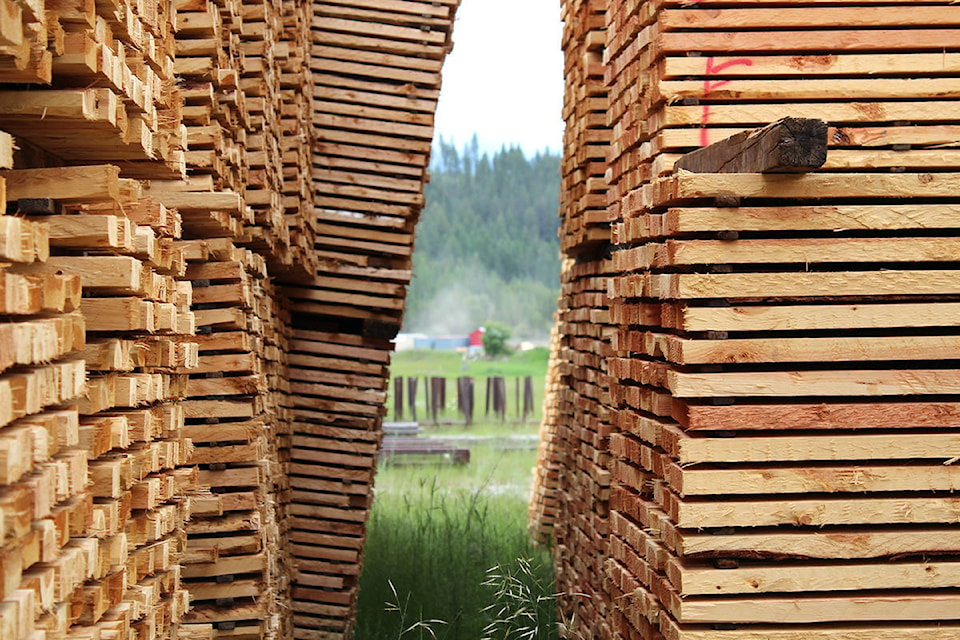A record demand and reduced supplies have pushed the price of 2x4s to historic highs but the B.C. forest industry is only just beginning to fully take advantage.
The industry has been plagued by an acute lumber shortage, which has been a long time in the making.
Lumber prices across North America have nearly tripled since 2019. Based on a weekly price report by the B.C. Ministry of Forests, Lands and Natural Resources, the price of SPF (spruce, pine, fir) 2x4 lumber – as of Sept. 18 – is at $1,288 per thousand board feet, up from a 2019 average annual of $499.
Skyrocketing prices during the past four or five months have upped the cost of building an average single-family home by $10,000 to $20,000, said Brett Giese, president and owner of Crowne Pacific Development Corp. and Veyron Properties Ltd.
“We were first faced with the challenges of price increases and now, despite record high prices the situation has been compounded by a shortage of supply,” said Giese.
Calling the dilemma a “once-in-a-lifetime phenomena” Joel Neuheimer, vice-president of international trade at Forest Products Association of Canada (FPAC) said the high price is because of increased demand after the onset of COVID-19.
Home renovation and remodelling projects that people began during lockdown coincided with construction projects that typically begin in spring. This led to increased demand for lumber across North America, including the United States, where B.C. exports 65 per cent of its lumber.
But the industry was not in a position to take advantage. Baggage from previous years – mill closures and curtailments, wildfires, pine beetle infestations, complex stumpage systems and regulatory policies, and a lengthy strike – had limited B.C.’s fibre supply.
There’s also uncertainty about consistent access to fibre which creates a cost burden for the industry, said Susan Yurkovich, president and CEO of the B.C. Council of Forest Industries (COFI).
“We had a 70 million cubic meter annual allowable cut in the Interior in 2007, that’s about 50 now and expected to go down, just under 40 by 2030,” she said.
There was a lot of downtime through 2019 and 2020 as prices dropped and a lot of lumber was coming off the market as mills were shutting down due to high cost structures, said Yurkovich,
It took a while for production to catch up with the demand, resulting in a lumber shortage between June and August. The shortage fed a 15 per cent drop in B.C.’s lumber export value, costing the industry more than $1 billion. Forest ministry statistics from July 2020 showed B.C.’s export value decreased year-to-date in July 2020 ($6.1 billion) compared to July 2019 ($7.5 billion).
The supply chain was further disrupted when production halted as mills in B.C.were shut for two to three weeks after the onset of the pandemic, creating a backlog on lumber orders.
RELATED: B.C. forest industry facing uncertain future as mills close across province
RELATED: Fewer trees, higher costs blamed for devastating downturn in B.C. forestry
The price of fibre in B.C. is extremely high relative to the rest of the Canada making it a high-cost jurisdiction that typically thrives under market conditions when lumber is expensive.
So, despite the lumber shortage, B.C.’s sawmills welcome the price hike as it helps them sustain their overhead. The real problem is when the lumber price goes low, said Yurkovich.
Come winter, lumber prices might go down, said Neuheimer, adding that construction typically slows then and picks up again during spring.
Yurkovich expects the fundamentals of supply and demand to remain fairly good for a while.
“So we might see a high price environment for a while but it is a commodity, so prices go up and down,” she said.
For more news from Vancouver Island and beyond delivered daily into your inbox, please click here.
